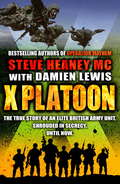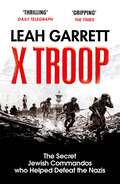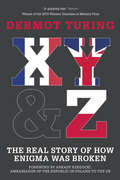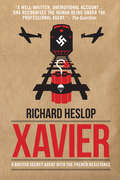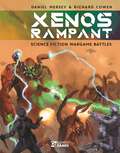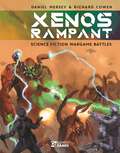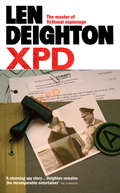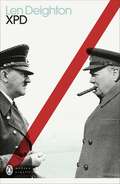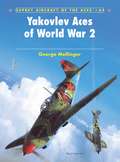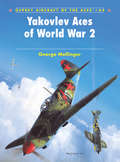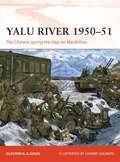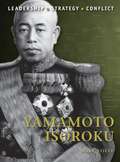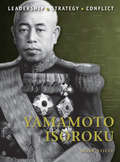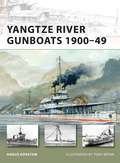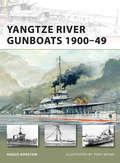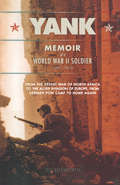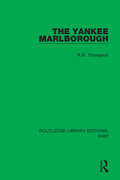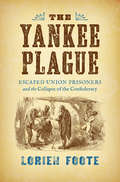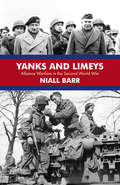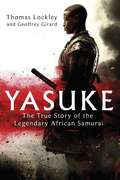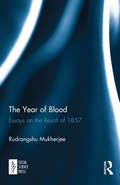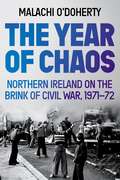- Table View
- List View
X Platoon
by Damien Lewis Steve Heaney, MCFor three decades one of the most secretive units in the British military has been a mystery force known as X Platoon.Officially there was no X Platoon. The forty men in its elite number were specially selected from across the Armed Forces, at which point they simply ceased to exist. X Platoon had no budget, no weaponry, no vehicles and no kit - apart from what its men could beg, borrow or steal from other military units.For the first time a highly decorated veteran of this specialised force - otherwise known as the Pathfinders - reveals its unique story. Steve Heaney became one of the youngest ever to pass Selection, the gruelling trial of elite forces, and was at the cutting edge of X Platoon operations - serving on anti-narcotics operations in the Central American jungles, on missions hunting war criminals in the Balkans, and being sent to spy on and wage war against the Russians.The first non-officer in the unit's history to be award the Military Cross, Steve Heaney reveals the extraordinary work undertaken by this secret band of brothers.
X Troop: The Secret Jewish Commandos Who Helped Defeat the Nazis
by Leah Garrett'This is Inglorious Basterds - but much better. Because it is the real story of clandestine Jewish fighters wreaking havoc against the Nazi war machine' Norman Ohler, author of BlitzedJune 1942. The shadow of the Third Reich has fallen across the entire European continent. In desperation, Winston Churchill and his chief of staff form an unusual plan: a new commando unit made up of Jewish refugees from Germany and Austria who escaped to Britain just before the War. Many have lost their families, their homes - their whole worlds. And now, in the crucial final battles against the Nazis, they will stop at nothing to defeat them. Trained in counterintelligence and advanced combat, this top secret unit becomes known as X Troop. Some simply call them a suicide squad.Drawing on extensive original research, including interviews with the last surviving members, Leah Garrett follows this unique band of brothers from Europe to England and back again, with stops at British internment camps, the beaches of Normandy, the battlefields of Italy and Holland, and the hellscape of Terezin concentration camp - the scene of one of the most dramatic, untold rescues of the war. For the first time, X Troop tells the astonishing story of these secret shock troops and their devastating blows against the Nazis.
X, Y & Z: The Real Story of How Enigma Was Broken
by Dermot TuringX, Y & Z describes how French, British and Polish secret services came together to unravel the Enigma machine. It tells of how, under the very noses of the Germans, Enigma code-breaking continued in Vichy France. And how code-breakers from Poland continued their work for Her Majesty’s Secret Service, watching the USSR’s first steps of the Cold War. The people of X, Y and Z were eccentric, colourful and caught up in world events that they could watch not control. This is their story…
Xavier: A British Secret Agent with the French Resistance
by Richard HeslopColnel Richard Heslop, alias Xavier, was one of Britain's Greatest Special Operations agents in France. Ingeniously orchestrating resistance groups and ruthlessly sabotaging German operations, Xavier played a crucial role in Allied espionage during the war, from late 1942 right through to D-Day. Sent to France in the middle of the conflict, he delicately balanced clandestine missions and dangerous wartime operations on a daily basis, yet his name barely gets a mention in the accounts of the Special Operations Executive (SOE), making this insight all the more fascinating. It is clear that Xavier's role was like no other. it was a job that involved frequent encounters with the terrifying possibilities of capture, torture and death; it was a job where a careless whisper could deliver a man into the hands of the Gestapo; and it was a job that involved acts of sabotage, espionage, theft, and sometimes even murder... Xavier is a dramatic and compelling account of courage and endurance in the face of a merciless enemy - the true story of one of Britain's greatest secret agents.
Xenos Rampant: Science Fiction Wargame Battles
by Daniel Mersey Richard CowenScience Fiction wargame rules for large skirmishes, based on the popular Rampant system.Xenos Rampant is a setting agnostic, large skirmish, miniature wargame for fighting science fiction battles using 28mm figures. Developed from the popular Lion Rampant ruleset, the core mechanics featured within will be instantly recognisable to those familiar with the other Rampant systems, while still being accessible to new players. Xenos Rampant contains all the rules, army lists, and scenarios required to fight science fiction battles as well as a whole host of subgenres including: post-apocalyptic, weird war, near future. So, whatever your science fiction preference, the rules can cover it – just let your imagination run rampant.
Xenos Rampant: Science Fiction Wargame Battles
by Daniel Mersey Richard CowenScience Fiction wargame rules for large skirmishes, based on the popular Rampant system.Xenos Rampant is a setting agnostic, large skirmish, miniature wargame for fighting science fiction battles using 28mm figures. Developed from the popular Lion Rampant ruleset, the core mechanics featured within will be instantly recognisable to those familiar with the other Rampant systems, while still being accessible to new players. Xenos Rampant contains all the rules, army lists, and scenarios required to fight science fiction battles as well as a whole host of subgenres including: post-apocalyptic, weird war, near future. So, whatever your science fiction preference, the rules can cover it – just let your imagination run rampant.
XPD (Penguin Modern Classics)
by Len Deighton'A stunning spy story ... incomparable' GuardianIt is the most dangerous secret of the Second World War, one that could destroy Britain's reputation forever. In 1940, a clandestine meeting took place between Churchill and Adolf Hitler. All records of it have been hidden, and anyone who discovers the truth dies - their file stamped XPD; Expedient Demise. But now what was buried is threatening to come to light, and SIS agent Boyd Stuart must stop it falling into the wrong hands, no matter how high the price.'Deliciously sharp and flawlessly accurate dialogue, breathtakingly clever plotting ... a splendidly strongly told story' The Times
Yakovlev Aces of World War 2 (Aircraft of the Aces)
by Jim Laurier George MellingerThe Yak-1 entered Soviet service in 1941, one of three modern types of aircraft accepted for production just prior to the German invasion of the USSR. Despite initial shortcomings, it soon proved to be the thoroughbred of the Soviet Airforce. Indeed, it remained in production until the end of the war, modernized but fundamentally recognizable. By VE-day about 33,100 Yakovlev fighters had been built. Virtually all Soviet fighter regiments flew at least one variety of Yak for a time, including those which gained their fame identified with other aircraft, and consequently many pilots known as Airacobra or Lavochkin aces also scored victories with the Yak. Many other famous aces were exclusively 'Yak patriots', including the French Normandie pilots. This book focuses on the Soviet aces who scored all, or most of their victories in the Yak, drawing informaion from official unit histories and memoirs of the Soviet pilots themselves.
Yakovlev Aces of World War 2 (Aircraft of the Aces)
by George MellingerThe Yak-1 entered Soviet service in 1941, one of three modern types of aircraft accepted for production just prior to the German invasion of the USSR. Despite initial shortcomings, it soon proved to be the thoroughbred of the Soviet Airforce. Indeed, it remained in production until the end of the war, modernized but fundamentally recognizable. By VE-day about 33,100 Yakovlev fighters had been built. Virtually all Soviet fighter regiments flew at least one variety of Yak for a time, including those which gained their fame identified with other aircraft, and consequently many pilots known as Airacobra or Lavochkin aces also scored victories with the Yak. Many other famous aces were exclusively 'Yak patriots', including the French Normandie pilots. This book focuses on the Soviet aces who scored all, or most of their victories in the Yak, drawing informaion from official unit histories and memoirs of the Soviet pilots themselves.
Yalu River 1950–51: The Chinese spring the trap on MacArthur (Campaign #346)
by Clayton K. ChunFollowing the Inchon landings and the breakout from the Pusan Perimeter, UN forces crossed the North Korean border on 9 October and moved on the capital Pyongyang. Many in America believed the war would be over by Christmas, but some Washington diplomatic, military, and intelligence experts continued to raise dire warnings that the People's Republic of China might intervene. Nevertheless, General MacArthur decided to push on to the Chinese/North Korean border, the Yalu River. On 25 October, Communist Chinese Forces unexpectedly attacked Republic of Korea forces near Unsan. Then, on 25 November, the day after MacArthur announced a 'final offensive to end the war', the Chinese 13th Army Group struck in mass against the Eighth Army in the north-west corner of North Korea, overrunning the US 2nd and 25th Infantry Divisions.The Chinese attacks quickly shattered Truman's dream of a unified Korea. American, UN, and ROK forces could not hold a successful defensive line against the combined CCF and NKPA attacks. At the Chosin Reservoir, US Marine Corps and Army units retreated south whilst MacArthur's forces withdrew from Pyongyang and X Corps later pulled out of Hungnam.Using expert research, bird's-eye views, and full-colour maps, this study tells the fascinating history of the critical Yalu campaign, including the famous retreat past the 38th Parallel.
Yalu River 1950–51: The Chinese spring the trap on MacArthur (Campaign #346)
by Clayton K. ChunFollowing the Inchon landings and the breakout from the Pusan Perimeter, UN forces crossed the North Korean border on 9 October and moved on the capital Pyongyang. Many in America believed the war would be over by Christmas, but some Washington diplomatic, military, and intelligence experts continued to raise dire warnings that the People's Republic of China might intervene. Nevertheless, General MacArthur decided to push on to the Chinese/North Korean border, the Yalu River. On 25 October, Communist Chinese Forces unexpectedly attacked Republic of Korea forces near Unsan. Then, on 25 November, the day after MacArthur announced a 'final offensive to end the war', the Chinese 13th Army Group struck in mass against the Eighth Army in the north-west corner of North Korea, overrunning the US 2nd and 25th Infantry Divisions.The Chinese attacks quickly shattered Truman's dream of a unified Korea. American, UN, and ROK forces could not hold a successful defensive line against the combined CCF and NKPA attacks. At the Chosin Reservoir, US Marine Corps and Army units retreated south whilst MacArthur's forces withdrew from Pyongyang and X Corps later pulled out of Hungnam.Using expert research, bird's-eye views, and full-colour maps, this study tells the fascinating history of the critical Yalu campaign, including the famous retreat past the 38th Parallel.
Yamamoto Isoroku (Command)
by Mark Stille Adam HookAdmiral Yamamoto Isoroku was the defining Japanese naval commander of World War II. Yamamoto's career in the Imperial Japanese Navy started in the early years of the 20th century and he saw service in the Russo–Japanese War, being wounded in the battle of Tsushima in 1904. He went on to study at Harvard University and serve as a naval attaché in the inter-war years, an experience that was to give him a unique insight into the American psyche. Despite the success of his daring pre-emptive strike on Pearl Harbor in 1941, that damaged the US Pacific Fleet and ushered in the Pacific War, Yamamoto's subsequent handling of the Japanese combined fleet can be called into question. The final campaign commanded by Yamamoto was that around Guadalcanal, where Yamamoto's myth of excellence will be totally laid bare. Despite a considerable numerical advantage over the Americans, Yamamoto never brought this advantage to bear. The result was a devastating defeat for the Imperial Japanese Navy and, eventually, the death of Yamamoto himself.
Yamamoto Isoroku (Command #26)
by Mark Stille Mr Adam HookAdmiral Yamamoto Isoroku was the defining Japanese naval commander of World War II. Yamamoto's career in the Imperial Japanese Navy started in the early years of the 20th century and he saw service in the Russo–Japanese War, being wounded in the battle of Tsushima in 1904. He went on to study at Harvard University and serve as a naval attaché in the inter-war years, an experience that was to give him a unique insight into the American psyche. Despite the success of his daring pre-emptive strike on Pearl Harbor in 1941, that damaged the US Pacific Fleet and ushered in the Pacific War, Yamamoto's subsequent handling of the Japanese combined fleet can be called into question. The final campaign commanded by Yamamoto was that around Guadalcanal, where Yamamoto's myth of excellence will be totally laid bare. Despite a considerable numerical advantage over the Americans, Yamamoto never brought this advantage to bear. The result was a devastating defeat for the Imperial Japanese Navy and, eventually, the death of Yamamoto himself.
Yangtze River Gunboats 1900–49 (New Vanguard)
by Tony Bryan Angus KonstamFrom the end of the 19th century through the first half of the 20th, most Western powers maintained a naval presence in China. These gunboats protected traders and missionaries, safeguarded national interests, and patrolled Chinese rivers in search of pirates. It was a wild, lawless time in China as ruthless warlords fought numerous small wars to increase their power and influence. This book covers the gunboats of all the major nations that stationed naval forces in China, including America, Britain, France, Germany, Italy, Portugal, and Japan, and looks at such famous incidents as the Japanese bombing of the USS Patay and the dramatic escape of the HMS Amethyst from Communist forces in 1947, which marked the end of the gunboat era.
Yangtze River Gunboats 1900–49 (New Vanguard #181)
by Tony Bryan Angus KonstamFrom the end of the 19th century through the first half of the 20th, most Western powers maintained a naval presence in China. These gunboats protected traders and missionaries, safeguarded national interests, and patrolled Chinese rivers in search of pirates. It was a wild, lawless time in China as ruthless warlords fought numerous small wars to increase their power and influence. This book covers the gunboats of all the major nations that stationed naval forces in China, including America, Britain, France, Germany, Italy, Portugal, and Japan, and looks at such famous incidents as the Japanese bombing of the USS Patay and the dramatic escape of the HMS Amethyst from Communist forces in 1947, which marked the end of the gunboat era.
Yank: Memoir of a World War II Soldier (1941-1945) - From the Desert War of North Africa to the Allied Inv
by Ted EllsworthTed Ellsworth was a young Dartmouth grad in 1941. In the years before the U.S. joined the Second World War effort, American men who wished to fight against Hitler were granted permission from President Roosevelt and the U.S. Congress to join the British army. In normal circumstance, fighting for another nation's army would be an automatic forfeiture of U.S. citizenship (as noted on U.S. passports). Yank begins with goodbyes to Ellworth's young wife and family. It covers his crossing to Britain, initial stay in London, assignment to a North African tank regiment and the campaign there, participation in the invasion of Italy and the second wave of D-Day, accounts of fierce battles, being taken prisoner by the Germans and shipped to a POW camp, the camp deprivations, liberation by the Russians, and finally, the year Ellsworth spent wandering eastern Europe with no dog-tags, after the war had ended, trying to reach a city from which he could ship back home. Ellsworth had been officially MIA for over two years, and everyone assumed he was dead. The final pages detail Ellsworth's homecoming when his wife hand-delivers the beautiful and intimate note that she'd written him when he was first reported missing.
The Yankee Marlborough (Routledge Library Editions: WW2 #48)
by R.W. ThompsonThis book, first published in 1963, is an early biography of Winston Churchill, examining his personality and character that was woven so closely through the texture of Britain’s story in the first half of the twentieth century. In attempting to discover a complete and complex Churchill, in his character, ambitions and personal experiences, the book seeks to present a clearer insight into the events of Churchill’s life.
The Yankee Marlborough (Routledge Library Editions: WW2 #48)
by R.W. ThompsonThis book, first published in 1963, is an early biography of Winston Churchill, examining his personality and character that was woven so closely through the texture of Britain’s story in the first half of the twentieth century. In attempting to discover a complete and complex Churchill, in his character, ambitions and personal experiences, the book seeks to present a clearer insight into the events of Churchill’s life.
The Yankee Plague: Escaped Union Prisoners and the Collapse of the Confederacy (Civil War America)
by Lorien FooteDuring the winter of 1864, more than 3,000 Federal prisoners of war escaped from Confederate prison camps into South Carolina and North Carolina, often with the aid of local slaves. Their flight created, in the words of contemporary observers, a "Yankee plague," heralding a grim end to the Confederate cause. In this fascinating look at Union soldiers' flight for freedom in the last months of the Civil War, Lorien Foote reveals new connections between the collapse of the Confederate prison system, the large-scale escape of Union soldiers, and the full unraveling of the Confederate States of America. By this point in the war, the Confederacy was reeling from prison overpopulation, a crumbling military, violence from internal enemies, and slavery's breakdown. The fugitive Federals moving across the countryside in mass numbers, Foote argues, accelerated the collapse as slaves and deserters decided the presence of these men presented an opportune moment for escalated resistance. Blending rich analysis with an engaging narrative, Foote uses these ragged Union escapees as a lens with which to assess the dying Confederate States, providing a new window into the South's ultimate defeat.
Yanks and Limeys: Alliance Warfare in the Second World War
by Niall BarrIn the mid-twentieth century the relationship between America and Britain had a chequered past. Theirs was a history of protection and oppression, of rebellion and ultimately war. But then the shared crisis of the Second World War brought Britain and America closer than ever before or since, and saw an unprecedented level of military cooperation. How was such a radical shift possible? To uncover how this historically fraught relationship recovered from its inauspicious start, Niall Barr goes back to the origins of their shared military history in the American War of Independence and shows how these early days had ramifications for the later crucial alliance. Picking up the tale with America’s entry into the Second World War, Niall Barr tells the story of these two armies as they fought in the largest war in history, from the uppermost echelons of the relationship between Churchill and Roosevelt right down to battlefield level and the soldiers fighting side by side for a common cause.
Yasuke: The true story of the legendary African Samurai
by Geoffrey Girard Thomas LockleyWARRIOR. SAMURAI. LEGEND.The remarkable life of history's first foreign-born samurai, and his astonishing journey from Northeast Africa to the heights of Japanese society.The man who came to be known as Yasuke arrived in Japan in the 16th century, an indentured mercenary arriving upon one of the Portuguese ships carrying a new language, a new religion and an introduction to the slave trade. Curiously tall, bald, massively built and black skinned, he was known as a steadfast bodyguard of immense strength and stature, and swiftly captured the interest, and thence the trust, of the most powerful family in all of Japan. Two years later, he vanished.Yasuke is the story of a legend that still captures the imagination of people across the world. It brings to life a little known side of Japan - a gripping narrative about an extraordinary figure in a fascinating time and place.
The Year of Blood: Essays on the Revolt of 1857
by Rudrangshu MukherjeeRudrangshu Mukherjee places the ‘soldier-peasant’ at the forefront of the Revolt. Violence has rarely been described with so much realism and subtlety. The imaginative use of primary source materials adds clarity to accounts such as the massacre in Satichaura Ghat and the trial of Mangal Pandey. The layers of complexity that defined the relationship between the rulers and the subjugated are also exposed.
The Year of Blood: Essays on the Revolt of 1857
by Rudrangshu MukherjeeRudrangshu Mukherjee places the ‘soldier-peasant’ at the forefront of the Revolt. Violence has rarely been described with so much realism and subtlety. The imaginative use of primary source materials adds clarity to accounts such as the massacre in Satichaura Ghat and the trial of Mangal Pandey. The layers of complexity that defined the relationship between the rulers and the subjugated are also exposed.
The Year of Chaos: Northern Ireland on the Brink of Civil War, 1971-72
by Malachi O'Doherty'Frank and incisive - an insightful look at the most tumultuous period of the Troubles.' Ian Cobain'This is the Belfast I grew up in. Malachi writes from first-hand experience and brings back memories that will always resonate with those who lived in those times.' Eamonn HolmesIn the eleven months between August 1971 and July 1972, Northern Ireland experienced its worst year of violence. No future year of the Troubles experienced such death and destruction. The 'year of chaos' began with the introduction of internment of IRA suspects without trial, which created huge disaffection in the Catholic communities and provoked an escalation of violence. This led to the British government taking full control of Northern Ireland and negotiating directly with the IRA leadership. Operation Motorman, the invasion of barricaded no-go areas in Belfast and Derry, then dampened down the violence a year later. During this whole period, Malachi O'Doherty was a young reporter in Belfast, working in the city and returning home at night to a no-go area behind the barricades where the streets were patrolled by armed IRA men. Drawing on interviews, personal recollections and archival research, O'Doherty takes readers on a journey through the events of that terrible year - from the devastation of Bloody Sunday and Bloody Friday to the talks between leaders that failed to break the deadlock - which, he argues, should serve as a stark reminder of how political and military miscalculation can lead a country to the brink of civil war.
